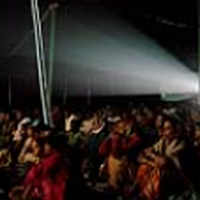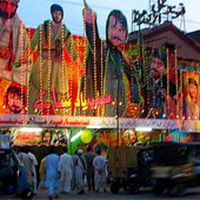The traveling screen: Exploring resonances between nomadic cinemas in India and Europe


Remote villages in the state of Maharashtra, in western India, remain one of the last stops of travelling cinemas in the world. For about six decades, patrons in these villages have played host to familiar guests: giant film screens, Bauer projectors, 35 mm film reels, enormous tents, modified trucks and antiquated speakers. Such epic cinema paraphernalia, has, over the years, forged strong bonds with the rustic milieu of the village as they accompany the jatras, old religious fairs, which travel to the hamlets each year. In contrast, such nomadic cinemas disappeared from the face of Europe mostly around the First World War in 1914.
A year after the ‘birth’ of cinema in Paris in 1895, Bombay, as Mumbai was formally known, saw its first cinema show at the Watson Hotel on July 7, 1896. The initial years of cinema in Maharashtra were predominantly an urban experience. Film shows were organised in hotels, open grounds and newly erected theatres in Bombay and the adjoining cities.
The jatras had, on their own, amassed a host of potential audiences in rural Maharashtra and found a cache of mythological films - the best fit for their audience. A host of unlikely players - electricians, school teachers and small-time businessmen acquired cinema paraphernalia and transported it to red-earth villages which lay waiting to welcome these new guests at their doorstep. Since then, many villages in western India await the annual arrival of these mobile cinemas, for their quota of large screen magic, since they are still situated far from fixed-site theatres.
The very idea of ‘exhibition’ through these travelling talkies puts the cinemas as part of local histories. It is significant to note how such a unique interaction of people and projected media at a specific place and occasion affects the narrative of evolution of cinema. Stephen P Hughes, who has pursued an extensive study of early cinema in south India, argues that the study of exhibition renders films as active agents, instead of finished and timeless objects. He also argues that we must relook at films as constantly being reiterated, remade and contested as ongoing social events within each act of the exhibition. Films are constantly rearticulated on the sites of public exhibition, and share a living and dynamic relationship with their viewers.
We had the wonderful opportunity of sharing some of these thoughts at a most fascinating workshop on the travelling media in Asia and Europe organized by the Cluster of Excellence, Heidelberg, the Media Studies Department at Trier University and the Cinémathèque de la Ville de Luxembourg. Exchanging thoughts with scholars working on early cinema in Europe was extremely enlightening as we heard from them about travelling cinemas in the region. On our part, we presented our work on the continuing journeys of itinerant tent cinemas in Maharashtra integrating themselves into religious fairs.
Early travelling cinemas found potential audiences within fairgrounds, which had traditionally been centres of collective socio economic activity. In Maharashtra, the fairs hosted by nodal villages even became places for matchmaking. It is in this localized space of a jatra that organized companies of tent cinemas found their first audiences who began worshipping screen gods after bowing their heads at the altar of the divine. Similarly, describing the journey of nomadic cinemas in Britain, Vanessa Toulmin[1] writes, “By the late 1890s, travelling fairs were one of the most important and popular venues for entertainment in Europe. Fairs occurred on dates fixed by the religious, industrial or agricultural calendar.”
Such fairground showmen developed and expanded the range of cinema by introducing it within a ready-made form of entertainment, introducing the knowledge and experience of moving pictures to masses. Not only did the fairs provide a perfect setting for the introduction of the cinemas, but the presence of these theatres also eventually fortified the fairs.
Another interesting observation is the reception to cinema not just by the audiences who were almost scared away by moving images, but also from the ruling powers of that time. The new medium of moving images was supposed to have immense power and reach, and also incite the supposedly weaker sections of society through its content - alien, foreign pictures. For example, Paul Lesch [2] described how a screening in 1902 at the Blaser Cinematograph show of a film depicting a surgical operation performed by Parisian doctor Eugene-Louis Doyen (most likely involving the separation of two conjoined sisters that took place the same year) was forbidden not only to underaged viewers but also to women, with the exception of female doctors with male accompaniment. Even in Maharashtra, women were initially made to sit separately from the men, facing the reverse side of the screen.
While the space of cinemas was accessible since it was embedded in another popular zone of social/religious fairs, it also provided conditional access and remained a gated zone. Incidentally, the introduction of mythological films strengthened the entry of women into the entertainments offered at the fairs. Even the restricted participation of women at the cinemas, made the old fairs, traditionally considered the sole preserve of male attendance, more inclusive.
When travelling cinemas took shape, they were primarily systems of exhibition - showing films borrowed from mainstream distribution centres. Gradually, the nature of mobile entertainment necessitated production of local content. In Luxembourg, Wendel Marzen’s Marzen’s Edison Elektrisches Theater which organized cinematograph shows since 1897, began shooting local films so as to raise the attractiveness of their show. Brigitte Braun[3] mentioned that the mobile cinema also targeted certain localities during special events. These included first communions, processions or carnivals, as well as regionally important events like Echternach Dancing Procession, visits by the emperor or international conventions.
This finds an interesting resonance in the cinemas in Maharashtra. Until now, these have been run like a family-owned business. The entry of independent players, not associated through a family business, has revived and resuscitated the system, often attempting to capitalise upon the specific themes that find patronage in the jatras. For example, actress Alka Kubal, civil engineer turned film distributor R S Patil (who stepped into the role of writer, director, producer, actor and even publicity manager for his film) and even unlikely candidates like vegetable seller turned music composer Arun Kachre who purchased a cinema as recently as 2004 after producing a top grossing mythological, are among a slew of new players who take on multiple roles and joined in. They produce films specifically targeting the jatras, and at times do not even find release in the town/city circuit.
Engaging with travelling cinemas - a distinct system of film exhibition and reception is an immensely insightful and deeply nostalgic experience. They beautifully preserve a collective, ritualistic viewing experience of cinema.
(Text Reference: Traveling cinemas in Asia and Europe- Sources and Perspectives. Edited by Dr. Martin Loiperdinger. KINtop Schriften 10. 2008)
By Shirley Abraham, a researcher and documentary film maker based in Mumbai, India
[1] Vanessa Toulmin is Research Director of the National Fairground Archive, Sheffield. She comes from a Lancashire showland family, and completed her PhD researching the social history of travelling showpeople
[2] Paul Lesch (PhD) teaches film and history in Luxembourg (Miami University John E. Dolibois European Center, Université du Luxembourg).
[3] Brigitte Braun is a media historian who teaches film history at Trier University. She has published on early local filmmaking and is registered for a doctoral thesis on film politics in the Rhineland during the 1920s.
Similar content
28 Oct 2009
By Kerrine Goh
30 Jun 2004
By Kerrine Goh
24 Jan 2012
posted on
13 Aug 2010
By Kerrine Goh
03 Jun 2005



